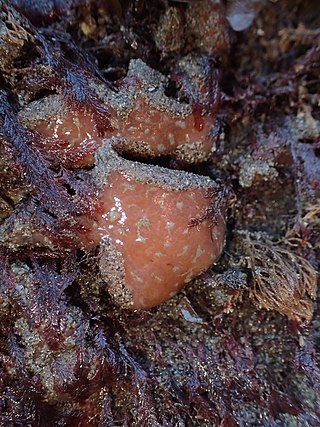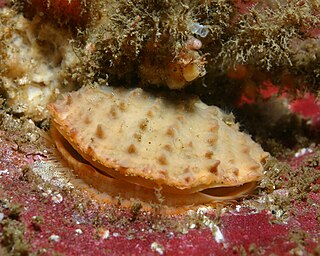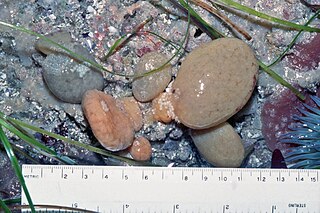
A tunicate is an exclusively marine invertebrate animal, a member of the subphylum Tunicata. This grouping is part of the Chordata, a phylum which includes all animals with dorsal nerve cords and notochords. The subphylum was at one time called Urochordata, and the term urochordates is still sometimes used for these animals. They are the only chordates that have lost their myomeric segmentation, with the possible exception of the seriation of the gill slits. However, doliolids still display segmentation of the muscle bands.

Ascidiacea, commonly known as the ascidians or sea squirts, is a paraphyletic class in the subphylum Tunicata of sac-like marine invertebrate filter feeders. Ascidians are characterized by a tough outer "tunic" made of a polysaccharide.

Ciona intestinalis is an ascidian, a tunicate with very soft tunic. Its Latin name literally means "pillar of intestines", referring to the fact that its body is a soft, translucent column-like structure, resembling a mass of intestines sprouting from a rock. It is a globally distributed cosmopolitan species. Since Linnaeus described the species, Ciona intestinalis has been used as a model invertebrate chordate in developmental biology and genomics. Studies conducted between 2005 and 2010 have shown that there are at least two, possibly four, sister species. More recently it has been shown that one of these species has already been described as Ciona robusta. By anthropogenic means, the species has invaded various parts of the world and is known as an invasive species.

Styela clava is a solitary, subtidal ascidian tunicate. It has a variety of common names such as the stalked sea squirt, clubbed tunicate, Asian tunicate, leathery sea squirt, or rough sea squirt. As its common names suggest, S. clava is club-shaped with an elongated oval body and a long peduncle for attaching to a substrate. Although native to the northwestern waters of the Pacific Ocean, since the 1900s, S. clava has become an increasingly successful invasive species outside of its native range. It is edible.

Botrylloides leachii is a colonial tunicate of the family Styelidae. Its unique methods of propagation and regeneration make it an ideal model organism for use in biological study of development, immunology, stem cells, and regeneration.

Corella willmeriana is a solitary tunicate in the family Corellidae. It is native to the eastern Pacific Ocean where it lives on the seabed at depths down to about 75 m (250 ft) between Alaska and California.

Clavelina picta, common name the painted tunicate, is a species of tunicate, in the genus Clavelina. These animals, like all ascidians, are sessile filter feeders.

Styela plicata, commonly known as pleated sea squirt, is a species of tunicate in the family Styelidae. This sessile filter feeder can expel water when threatened.

Aplidium californicum is a species of colonial sea squirt, a tunicate in the family Polyclinidae. It is commonly known as sea pork.

Aplidium solidum is a species of colonial sea squirts, a tunicate in the family Polyclinidae. It is commonly known as the red ascidian or sea pork.

Crassadoma is a genus of rock scallops, marine bivalve molluscs in the family Pectinidae. It is monotypic, the only species being Crassadoma gigantea, the rock scallop, giant rock scallop or purple-hinge rock scallop. Although the small juveniles are free-swimming, they soon become sessile, and are cemented to the substrate. These scallops occur in the eastern Pacific Ocean.

Didemnum vexillum is a species of colonial tunicate in the family Didemnidae. It is commonly called sea vomit, marine vomit, pancake batter tunicate, or carpet sea squirt. It is thought to be native to Japan, but it has been reported as an invasive species in a number of places in Europe, North America and New Zealand. It is sometimes given the nickname "D. vex" because of the vexing way in which it dominates marine ecosystems when introduced into new locations; however, the species epithet vexillum actually derives from the Latin word for flag, and the species was so named because of the way colonies' long tendrils appear to wave in the water like a flag.

Pyura pachydermatina is a sea tulip, a solitary species of tunicate in the suborder Stolidobranchia. It is native to shallow waters around New Zealand.
Molgula occulta is a species of solitary tunicate in the family Molgulidae. It is native to the north eastern Atlantic Ocean, the North Sea and the Mediterranean Sea. The specific name occulta means "tailless" and refers to the tunicate's larva, which lacks the tail found in some other species in the genus Molgula.
Polycarpa fibrosa is a species of tunicate in the family Styelidae. It is brown and globular and its outer surface is covered with a mat of fibrils. It normally lies buried in soft sediment on the seabed with only its two siphons protruding. It occurs in the Arctic Ocean and northern Atlantic Ocean. P. fibrosa was first identified and described by the American malacologist William Stimpson in 1852.
Molgula citrina is a species of solitary tunicate in the family Molgulidae. It is found on both sides of the northern Atlantic Ocean and in the Arctic Ocean. In 2008 it was found in Kachemak Bay in Alaska, the first time it had been detected in the Pacific Ocean.

Polyclinum planum is a compound ascidian commonly known as the elephant ear tunicate. It is an ascidian tunicate in the family Polyclinidae. Ascidians are also known as sea squirts.

Phallusia mammillata is a solitary marine tunicate of the ascidian class found in the eastern Atlantic Ocean and the Mediterranean Sea.

Molgula manhattensis, commonly known as "sea grapes", is a species of ascidian commonly found along the East Coast and Gulf Coast region of the United States. Although it is native to this region, it has been introduced to other areas of Europe, Australia, and the West Coast.

Pyura haustor is a species of sessile ascidian, or sea squirt, that lives in coastal waters in the north-eastern Pacific Ocean, attached to rocks or artificial structures. Common names for this species include the wrinkled seapump, the wrinkled sea squirt and the warty tunicate.
















